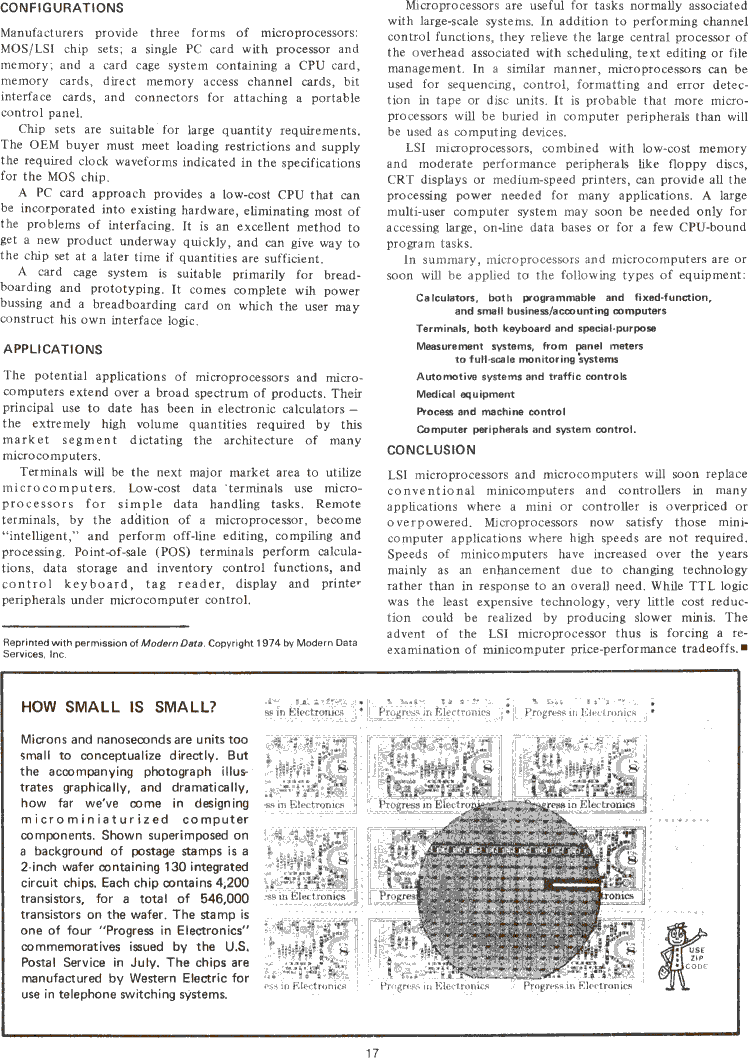The Best of Creative Computing Volume 2 (published 1977)
Microprocessors and Microcomputers - The State of The Art (Configurations, Applications, Conclusion, How Small Is Small?, Reprinted from Modern Data, 1974)

CONFIGURATIONS
Manufacturers provide three forms of microprocessors: MOS/LSI chip sets; a
single PC card with processor and memory; and a card cage system containing a
CPU card, memory cards, direct memory access channel cards, bit interface cards,
and connectors for attaching a portable control panel.
Chip sets are suitable for large quantity requirements. The OEM buyer must meet
loading restrictions and supply the required clock waveforms indicated in the
specifications for the MOS chip.
A PC card approach provides a low-cost CPU that can be incorporated into
existing hardware, eliminating most of the problems of interfacing. It is an
excellent method to get a new product underway quickly, and can give way to the
chip set at a later time if quantities are sufficient.
A card cage system is suitable primarily for breadboarding and prototyping. It
comes complete with power bussing and a breadboarding card on which the user may
construct his own interface logic.
APPLICATIONS
The potential applications of microprocessors and microcomputers extend over a
broad spectrum of products. Their principal use to date has been in electronic
calculators – the extremely high volume quantities required by this market
segment dictating the architecture of many microcomputers.
Terminals will be the next major market area to utilize microcomputers.
Low-cost data ˙terminals use microprocessors for simple data handling tasks.
Remote terminals, by the addition of a microprocessor, become "intelligent," and
perform off-line editing, compiling and processing. Point-of-sale (POS)
terminals perform calculations, data storage and inventory control functions,
and control keyboard, tag reader, display and printer peripherals under
microcomputer control.
Microprocessors are useful for tasks normally associated with large-scale
systems. ln addition to performing channel control functions, they relieve the
large central processor of the overhead associated with scheduling, text editing
or file management. ln a similar manner, microprocessors can be used for
sequencing, control, formatting and error detection in tape or disc units. It
is probable that more microprocessors will be buried in computer peripherals
than will be used as computing devices.
LSI microprocessors, combined with low-cost memory and moderate performance
peripherals like floppy discs, CRT displays or medium-speed printers, can
provide all the processing power needed for many applications. A large
multi-user computer system may soon be needed only for accessing large, on-line
data bases or for a few CPU-bound program tasks.
In summary, microprocessors and microcomputers are or soon will be applied to
the following types of equipment:
Calculators, both programmable and fixed-function, and small business/accounting
computers
Terminals, both keyboard and special-purpose
Measurement systems, from panel meters to full-scale monitoring systems
Automotive systems and traffic controls
Medical equipment
Process and machine control
Computer peripherals and system control.
CONCLUSION
LSI microprocessors and microcomputers will soon replace conventional
minicomputers and controllers in many applications where a mini or controller is
overpriced or overpowered. Microprocessors now satisfy those minicomputer
applications where high speeds are not required. Speeds of minicomputers have
increased over the years mainly as an enhancement due to changing technology
rather than in response to an overall need. While TTL logic was the least
expensive technology, very little cost reduction could be realized by producing
slower minis. The advent of the LSI microprocessor thus is forcing a
reexamination of minicomputer price-performance tradeoffs. ▪
Reprinted with permission of Modern Data. Copyright 1974 by Modern Data
Services, Inc.
[image]
HOW SMALL IS SMALL?
Microns and nanoseconds are units too small to conceptualize directly. But the
accompanying photograph illustrates graphically, and dramatically, how far we've
come in designing microminiaturized computer components. Shown superimposed on
a background of postage stamps is a 2-inch wafer containing 130 integrated
circuit chips. Each chip contains 4,200 transistors, for a total of 546,000
transistors on the wafer. The stamp is one of four "Progress in Electronics"
commemoratives issued by the U.S. Postal Service in July. The chips are
manufactured by Western Electric for use in telephone switching systems.
[image]
17


